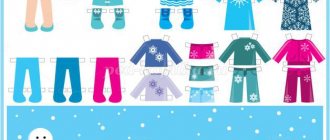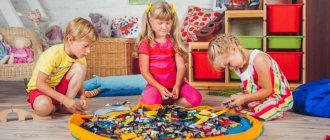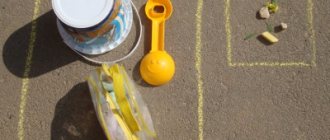Game - an activity with didactic material in an early age group
Summary of a game-activity in a group of young children on the topic: “Rolling red and blue balls into the goal.”
Compiled by: Elena Anatolyevna Yanchenko, teacher at MBDOU “Kindergarten No. 11” in Seversk, Tomsk Region Purpose: familiarization with the shape, color of objects and their properties. Objectives: • develop children’s ability to roll balls into the goal, performing actions according to the teacher’s word; • to develop children’s ability to identify identical differences in the color of objects; • continue to develop fine motor skills of the hands and eye; • cultivate a desire to play. Vocabulary: ball, blue, red, gate, rolling. Material: gates, balls, red and blue buckets.
Progress of the game-lesson:
1. Surprise moment. A doll comes to visit the children and brings buckets of balls. Educator: Guys, look, someone has come to us. Who is this? (Children's answers.)
- That's right, it's a doll.
The doll's name is Katya. The doll came to visit us and brought something. Let's get a look. 2. Main part. The teacher and the children examine buckets of balls. Educator: who knows what this is? (Children's answers.)
- Yes, it's a bucket.
What color is it? (Children's answers.)
- That's right, this bucket is red.
But the bucket is not empty, there is something in it. The teacher takes a ball out of the bucket and shows it to the children. Educator: guys, what is this? (Children's answers.)
- That's right, it's a ball.
What color is the ball? (Children's answers.)
- Yes, the ball is also red.
Well done boys. Look, there are red balls in a red bucket. In the same way, the teacher and the children examine a blue bucket with balls. Educator: we know that balls are round in shape and can be rolled. Let's say together what you can do with balls? - That's right, you can roll the balls. You can roll the ball along the floor, or you can roll it through the gate. Look, I have a gate. What is this? (Children's answers.)
- This is the gate.
What color is the gate? (Children's answers.)
- Yes, these gates are red, and these ones are blue.
I will take a red ball and pump it through the red gate: Roll the red ball, show yourself to our children! “The red ball rolled into the red gate.” And now I’ll take a blue ball and pump it through the blue gate: Roll the blue ball, show yourself to our children! - So the blue ball rolled into the blue gate. How amazing. Next, children conduct practical activities.
The teacher calls the child's name and invites him to take a red or blue ball from the bucket and roll it into the goal of the desired color.
In this case, the “say-repeat” technique is used. Educator: These are the different balls, Blue and red. They roll on the floor towards Vanechka and Arinochka. - Well done guys, we rolled the balls into the goal. And now our children will go and collect the balls in buckets. We will collect red balls in red buckets, and which bucket will we collect blue balls in? (Children's answers.)
- Yes, we will collect the blue balls in a blue bucket.
The outdoor game “Collect balls into buckets” is played. 3. Bottom line. Educator: Well done our children, they collected all the balls into buckets. Guys, what did we do with you today? (Children's answers.)
- We rolled balls into the goal.
What color balls did the doll Katya bring us? (Children's answers.)
- Yes, the doll brought us red and blue balls?
Show me where the red balls are? - That's right, red balls are in a red bucket, and blue balls are in a blue bucket. Doll Katya really liked how our children played. And now the doll needs to go to other children, they also want to play with the balls. Children say goodbye to the doll.
We recommend watching:
Joint activities in an early age group. Synopsis of a lesson with children in the first year of life Synopsis of a joint educational activity for children of the 1st junior group “Winter-Winter” Complex thematic lesson in an early age group together with mothers
Similar articles:
Lesson summary for an early age group. Cockerel
Lesson summary for an early age group. Dandelion
Summary of a game developmental lesson in an early age group on the topic: Rays of the sun
Game development activity in kindergarten for children of the third year of life
Lesson summary for the first early age group on the topic: Toys
Summary of a didactic game for early ages lesson plan (junior group) on the topic
Summary of a didactic game for young children (1st junior early age group)
Game “Different mugs for the hare and squirrel”
Goal: developing ideas about color and shape.
Program content
Educational task: to teach children to distinguish an object by shape and name it. Continue to introduce children to animals such as the hare and squirrel.
Identify and name the distinctive features of animals;
Developmental: stimulate the cognitive interest of children, promote the development of memory, attention, and intelligence. Educational: cultivate a humane and caring attitude, love for animals.
Vocabulary work
Activation of the dictionary: green, red, circle, house, car, fox, hare
Enrichment of vocabulary: carpet, furniture, repairs
Equipment: red and green circles cut out of colored paper, cars, fox and hare toys, two toy animal houses.
Game task: select rugs for the hare and the squirrel.
Game rule: select the correct mats and load them onto the cars of the corresponding colors.
| Stages | Activities of the teacher | Activity children | Methodical techniques and instructions |
| I. Introductory Part | - Hello children! I suggest that the children come up and see what the teacher has in his hands. These are houses - one house is for a squirrel, and the other is for a hare. I'm putting up houses. - Look who came visit them! — A squirrel and a hare came to visit us. They came to you for your help. The squirrel and the hare renovated the houses - they bought furniture, and decided to lay new rugs on the floor. — Please help the animals choose rugs - the squirrel and the hare love rugs that look like circles. | Approach the teacher Listen to what the teacher says | Game moment Motivation |
| II. Main part | I bring the children (two boys and two girls) to the “store” - he shows rugs: green and red (circles made of colored paper). The squirrel immediately liked the red rugs, the hare - green. What color rugs does a squirrel need? And for the bunny? - Let's select the red rugs for the squirrel and load them onto the red car. - And green mats on a green car are for the bunny. - All the rugs have been taken away, the squirrel and the bunny say thank you for helping them. - Goodbye! | Go with a teacher Considering rugs Answer -red -green They select the rugs by color and “load” them into the backs of green and red cars – for the bunny and the squirrel. - Listen to the teacher They say - goodbye to the squirrel and the hare Waving a pen | Consideration Choral speaking Explanation rules of the game |
| III. Conclude body Part | Well done, you did your best for the squirrel and the hare. Now they won't freeze in winter - they have rugs. | Listen to the teacher They say - Yes | Praises children |
Didactic games: concept and types
An educational game is a type of educational activity organized in a playful form. Classes implement the principles of playful and active learning, are subject to a number of specific rules, have a strict structure and a system of monitoring and evaluation tools.
Didactic games for children 2-3 years old: how to develop a child.
The games in question, as well as active and musical ones, were created by adults (educator, parent) and are offered ready-made. First, children master the game with the help of its developers, study the rules, norms of action, and over time, having mastered the necessary content, begin to play it on their own.
Such classes are one of the main ones in preschool educational organizations, therefore they are used by educators at all stages of children’s development: the first junior group (2-3 years), the second junior group (3-4 years), the middle one - 4 years. -5 years, senior – 5-6 years, preparatory – 6-7 years.
Properly organized didactic games develop:
- mental and cognitive abilities: children assimilate new information, generalize and consolidate it, expand their knowledge about various objects, phenomena of the surrounding reality, the flora and fauna. Memory, all kinds of attention, observation skills develop, children learn to express judgments and conclusions;
- speech – in speech activity the active vocabulary is replenished and updated;
- social and moral values - children learn relationships between themselves and adults, between objects of living and inanimate nature, children learn to empathize, give in to each other, be fair, and attentive towards others.
Typically, the games under consideration are divided into 3 main groups:
- Games with objects (toys) are aimed at direct perception of a thing and actions with it, so the child knows the characteristics of this object, its shape, color. Working with different toys, children can compare them with each other, find common and different ones. This type of activity allows you to organize independent activities, develop the ability to occupy yourself and not disturb others in the group.
- Printed board games are aimed at getting to know the surrounding reality, flora, fauna, and phenomena of living and inanimate nature. Such tasks contribute to the development of language skills, logic, attention, teach how to simulate life situations, make decisions, and train self-control skills.
- Word games: develop preschoolers' thinking and language. These games are based on a word that allows you to train the ability to solve various mental problems: describe the properties and characteristics of things or phenomena, highlight their main characteristics, compare different objects (phenomena) with each other, guess them. Description.
What else to read: Didactic games for the development of speech in preschoolers. speech therapy file on the topic
Educational games for children (2-3 years and older) are conducted by the teacher or parents, and they organize the lesson by introducing the content and rules of the game, its course of action, through a clear example of how to play. The game ends with summing up and analysis, which allows us to identify the individual characteristics of children.
DIY didactic game
Educational games for little ones:
- “Feed the bun.” The goal is to develop fine motor skills in children. Description: You will need two small plastic containers, one of which should be round. We glue a funny face (bun) onto the lid, make a hole in place of the mouth, and put beans in the second jar. The child’s task is to feed the bun, that is, put the beans in a jar with a cup.
- “carnations and rubber.” The goal is to train fine motor skills, visual, chromatic and spatial perception, and study geometric shapes. Description: Cut out a square of the required size from plywood, paint it, fasten clergy nails at equal distances throughout the space, the child's task is to create various geometric shapes, simple objects (for example a spruce) using a rubber bench strip).
Classes for middle group children:
- "Box of sensations" The goal is to develop motor skills, imagination, and the ability to identify an object by its shape. Description: Take a shoe box, make two holes in the lid and sew fabric sleeves to it, put various items in the box and cover with the lid. The children’s task is to put their hands in their sleeves, find the object, guess and describe it.
- "Musical sweets" The goal is to develop auditory attention, memory, and thinking. Description: Insert various items from a kind surprise into the eggs: beads, cereals, paper clips, line the blanks with a cloth in the form of candies (each sound should have a pair). The children's task is to find identical pairs of candies.
Games for older preschoolers:
- "The world of flora and fauna." The goal is to develop the ability to observe, analyze, generalize, and instill a love for living nature and respect for it. Description: cut out representatives of flora and fauna, glue cardboard. The children's task is to look at a postcard with an animal or plant, describe it, highlight the main features, etc.
- "Mosaic". The goal is to develop attention, logical thinking, and color perception. Description: Prepare various geometric shapes from colored paper, except for a circle. The children’s task is to make a mosaic out of these figures in such a way that the same colors do not touch.
What else to read: Didactic game “Guess the sport.” presentation on physical education
Didactic games allow you to develop all important processes: speech, attention, thought, imagination. Such activities are useful not only for children 2-3 years old, but also for middle and older groups. The variety of games allows the teacher to choose the one that will be aimed at the development of each child.


